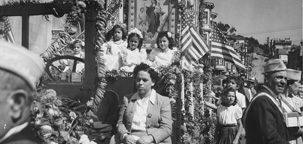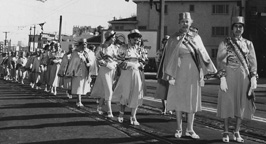The annual Italian Heritage Parade in North Beach is a chance for local Italian-Americans to proudly honor the outstanding achievements of their ancestors. For the rest of The City, itís a fun reminder of the cultural footprint left behind by the thousands of Italian-born immigrants who planted new roots here in the Bay Area.

Annual Sicilian ritual gives thanks to the Madonna of Light during a week-long celebration of heritage in North Beach
By Bill Picture
Published: October, 2005
The annual Italian Heritage Parade in North Beach is a chance for local Italian-Americans to proudly honor the outstanding achievements of their ancestors. For the rest of The City, it’s a fun reminder of the cultural footprint left behind by the thousands of Italian-born immigrants who planted new roots here in the Bay Area.
But what many of the 400,000-or-so revelers who turn out for the event each year may not realize is that the Italian Heritage Parade, which takes place on the Sunday before Columbus Day, has strong ties to northern Italy, particularly Genoa, where the famous 15th-century explorer is believed to have been born.
For the thousands of Sicilian-Americans in the Bay Area, and those with roots in the south of the boot-shaped Italian peninsula, the chance to celebrate their proud ancestry comes a week earlier, when they take to the bay and to the streets of North Beach for the annual Madonna del Lume Celebration.
Descendants believe the annual ritual began in Sicily some time during the 1700s, when a group of fishermen from the small village of Ponticello lost their way at sea and prayed to the Madonna del Lume (Madonna of the Light) to help them find their way home. According to the legend, the fishermen’s prayers were answered when a light suddenly appeared in the sky and guided them safely back to shore.
Ever since, the Madonna del Lume has been regarded as the patron saint of fishermen, and Sicilians have been gathering every October to pay homage to her and to honor the lives of fishermen who weren’t quite so lucky.
This "thank you" to the Madonna de Lume tradition was brought over to America by Sicilian immigrants, who arrived in the Bay Area in droves, beginning in the mid-1800s. The tradition continued in San Francisco, on a relatively small scale for many years, The first official Madonna del Lume Celebration didn’t take place until 1936, but has grown considerably over the course of its seventy-year history.
What began as a simple mass honoring the lives of fisherman lost at sea, followed by a priest’s blessing of the fishing fleet, is now a colorful, weekend-long celebration of Sicilian culture.
Festivities begin early on Saturday morning with a memorial mass at the Fisherman’s and Seaman’s Memorial Chapel at Fisherman’s Wharf, the soul of the Bay Area’s Catholic fishing community. The mass is followed by a fishing boat procession to the mouth of the Golden Gate, where a memorial wreath ceremony takes place.
Then on Sunday, a high mass in Italian dedicated to the Madonna del Lume takes place at Saints Peter and Paul Church in North Beach, followed by a parade down Columbus Avenue to Fisherman’s Wharf, where a priest blesses the fishing fleet. The celebration wraps that evening with a cocktail reception and dinner-dance at the Hyatt at Fisherman’s Wharf.
One of the highlights of the weekend is the annual crowning of the Queen of the Madonna del Lume Celebration, where a young member of the Sicilian-American community is chosen to serve as a role model for other young women in the community, and to preside over the weekend’s festivities. This year’s queen is 16-year-old, Concord native, Gabriella Crivello, who has been involved with the Celebration in various capacities since she was a child.
Frank Lavin, a North Beach native and one of the organizers of the event, participated in his first Madonna del Lume Celebration as a flag-bearer when he was nine-years-old. But he says he learned the story of the Madonna del Lume years earlier from his Sicilian grandfather, who helped found Fisherman’s Wharf and operated a crab stand there for many years.
"I would look forward to [the event] all year," he says. "We all did, my family and the other families in the neighborhood. It was definitely a big deal for the Sicilian community. And it still is for many of us."
North Beach has changed quite a bit since Lavin was a young boy. The once largely working-class Italian-American neighborhood, like the rest of San Francisco, is now a cultural mixed-bag. In fact, the row of pasta joints lining Columbus Avenue is one of the few visible reminders of North Beach’s Italian roots.
Over the years, many of the Italian families who once called North Beach "home" have left the old neighborhood. But even though the Italian-American community has spread across both bridges and down the Peninsula, Lavin says North Beach continues to serve as its cultural center; and the Madonna del Lume Celebration, is a Sicilian-American’s pride and joy.
"Most still have strong ties to North Beach for one reason or another," Lavin says. "Either you grew up here, or you still have family here, or you go to church here. Saints Peter and Paul Church is really the rock of the Italian-American community here in the Bay Area. It’s like a beacon, guiding us all back to North Beach."
The fishing industry in San Francisco isn’t what it used to be either. As a kid, Lavin says that all of the men in his family (and many of the women) put in long hours down at Fisherman’s Wharf. But subsequent generations have traded their rubber boots and gloves for business suits and briefcases, and their stake in the family business, for the relative comfort of a desk job. Lavin himself, a Berkeley graduate, works as a financial advisor in San Francisco.
"I wasn’t cut out to be a fisherman," he jokes. "I worked [down at Fisherman’s Wharf] all through high school and college and, I’m telling you, it’s backbreaking work. I saw how hard my uncles had to work. That’s why I went to college."
Fishing is just one of many long-held traditions brought over by Sicilian families from the old country that has since fallen by the cultural wayside. But rather than allow the Madonna del Lume Celebration to fizzle out and fade away, Lavin says that he and the other members of the organizing committee are determined to keep this centuries-old tradition alive.
"We want to keep it alive for our children’s sake," he explains. "I want my kids to know where they came from. I mean, I’m proud of our success and I’m proud of how well [Italian-Americans] have assimilated in this country. But I think it’s important that future generations understand at least a little bit about the old way."
"So, in addition to being for those who still do fish, the [Madonna del Lume Celebration] has sort of taken on another, much more symbolic meaning for me and for the rest of the Sicilian community. In a nutshell, it’s really about three things: faith, family and friends."
Remembrance remains an important and irreplaceable part of this holy event, but Lavin insists that the Madonna del Lume Celebration is also a time for the Sicilian-American community and its friends to kick up their heels.
"It’s a celebration, after all," he adds. "It says so right there in the name. There’s music and floats and dancing. It’s a holy event and there are solemn aspects of it, but it’s also a party. [Sicilians] love a good party."
Madonna del Lume Celebration
October 1-2, 2005.
Call (415) 749-0250 for details.



